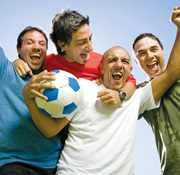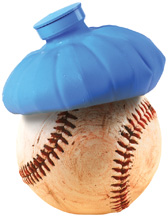All Hail the Weekend Warrior
Making a Quick Recovery and Preventing Future Injury
By Dr. Marc Heller
Most of us work during the week at sedentary jobs and then try to be weekend warriors. When we're young, we usually can get away with this. But aging tendons, muscles and joints are not so forgiving. It's easier to strain them and much harder to recover. What can you do? First, find an exercise you can do during the week to get you ready for the weekend. If your first love is softball and you only have time for it on the weekend, how can you get in shape for the softball game? You could do some warm-ups and brief sprints after work a few times a week. You could lift weights. You could help maintain your flexibility through Pilates, yoga, or a home stretching and toning routine. Do the Work Think about what your "weekend warrior" activity involves and try to do something during the week that challenges the same muscles and movements you'll be making on the weekend. The key is consistency. If you're doing something, anything, to stay in shape during the week, you are less likely to get injured and more likely to recover quickly.
 I know, you love softball, mountain hikes, kayaking, golf, tennis or whatever, and there's no time during the week for these activities. Find some exercise that allows you to be successful at the activity you love on the weekend. Suck it up and do the work. The weekday workouts might not give you the pleasure of your weekend game, but it will allow you to participate in your weekend passion with much less risk. You'll perform better, and you'll be both stronger and faster. If you want to continue to perform at a reasonably high level in any sport, you have to have the mindset of an athlete. That means training for your sport.
I know, you love softball, mountain hikes, kayaking, golf, tennis or whatever, and there's no time during the week for these activities. Find some exercise that allows you to be successful at the activity you love on the weekend. Suck it up and do the work. The weekday workouts might not give you the pleasure of your weekend game, but it will allow you to participate in your weekend passion with much less risk. You'll perform better, and you'll be both stronger and faster. If you want to continue to perform at a reasonably high level in any sport, you have to have the mindset of an athlete. That means training for your sport. Certain activities get harder as we age. The qualities that make it more difficult are fairly clear. Can you warm up and then get more active, or does the activity require sudden, explosive motions from a total standstill? Are the motions of the sport fairly smooth, or does the sport require sudden jumps and twists? The problem with softball is that you mostly sit or stand around, and then suddenly have to sprint or twist with 100-percent effort. The benefit of hiking is that you can start out slow and gradually go faster once you've warmed up. Think about your activity from this perspective. In general, softball, basketball and running tend to be young people's activities. Tennis, hiking, bicycling and swimming are activities that can last essentially a lifetime. Gardening is a tough one. Everyone wants to be out there in their garden, but gardening involves lots of bending, stooping, lifting and pulling. It's not the best activity for someone with a vulnerable lower back. If you're a golfer, you're better off walking between holes rather than using a cart. This will keep you warmed up and less likely to strain cold muscles. I used to be a downhill skier; now, I cross-country ski. I used to be a hard-shell whitewater kayaker; now, I do short jaunts in my flat-water kayak on lakes. I've been willing to change my activities while still staying active. You might need to do the same. Some people can get away with just about anything, no matter how old they are or how well they've prepared. Most of us have to be more careful and diligent. You can extend your "season" and keep doing what you love if you take care of yourself. You probably know what to do; you just need to prioritize it. When Injury Strikes What can you do when injury strikes? It's going to happen sooner or later. The basic principle: provide an optimal environment for healing. This has various aspects. Keep moving if you can. If you feel a little sore when you perform your sport or activity, but better after you warm up, and you're not sore that night or the next day, great! You can still do your sport. If you continue to hurt during your activity, if you are limping, if you hurt worse that night or the next morning, you'd better back off, or you'll risk further injury. Pay attention to the area you injured. Make sure you warm that local area up well, before you go full speed. Ice almost always is great. Apply cold for 15-20 minutes, being careful not to injure your skin with the ice pack. You can use various liniments or homeopathic remedies applied to the injured area. Anti-inflammatory medicine, such as ibuprofen or Aleve, actually will block healing of tendons and muscles. Immediately after an injury, the body is trying to use inflammation to create healing to lay down new tissue. You need to learn to listen to your body. How bad is the injury? Can you still move normally? What hurts? Most minor injuries will heal on their own relatively quickly. I tell my patients that if something isn't getting obviously better within a week, they need to call me and get assessed. Some injuries are more obviously serious and need immediate attention. Weekend warriors have a tendency to be good at denial. Don't wait forever to get help because it just makes it harder to get your body right again. Go out and enjoy your outdoor activities, your sport, your passion. But use common sense and pay attention to your body. Taking care of yourself, both preventively and post-injury, will ensure you continue to have a good time doing what you truly enjoy. Hot or Cold: Which Is Better When Treating an Injury? For an answer to this often-asked question, let's hear what Dr. Jessica Heller, a chiropractor and certified strength and conditioning specialist in Wisconsin, has to say: Both heat and ice improve healing by manipulating blood flow, reducing inflammation and reducing pain. Knowing which one to use when, though, will keep you from possibly doing further damage. Cold Treatment: Ice should be used on acute injuries (injuries that have occurred within the last 72 hours). [The] aim is to limit the body's response to the injury. It does this by reducing further bleeding into the injured tissues, preventing or reducing swelling, and reducing muscle spasm and pain. Ice should also be used for chronic conditions (arthritis, tendonitis, overuse injuries in athletes), but after activity. This will help control the inflammatory response. There are several methods for icing an injury. The first uses an ice pack. Place a thin layer of cloth over the injury to avoid frostbite. Place the ice pack over the cloth. Leave the ice on for 20 minutes. It is normal to go through the phases of cold, burning, and then numbness. Do not leave the ice on for more than 20 minutes, or you can do more harm than good. Ideally, ice on an acute injury should be applied every 2-3 hours. Heat Treatment: Heat should be used for chronic injuries to relax and loosen the tissues and stimulate blood flow to the area. Heat should be used before activities, not after. Do not use heat after an acute injury. It will increase bleeding and make the problem worse.
 Moist hot towels are the most effective form of heat treatment. They are more effective because the moisture keeps the area from drying out and becoming brittle. Place a washcloth under hot tap water, or heat it up slightly in the microwave, and then apply it directly to the injured area. Heating pads will also work, as well as hot water bottles and soaking in a hot bath. Do not apply for more than 20 minutes at a time. Never fall asleep on a heating pad, and do not apply body weight to the heating pad (do not sit or lie on it).
Moist hot towels are the most effective form of heat treatment. They are more effective because the moisture keeps the area from drying out and becoming brittle. Place a washcloth under hot tap water, or heat it up slightly in the microwave, and then apply it directly to the injured area. Heating pads will also work, as well as hot water bottles and soaking in a hot bath. Do not apply for more than 20 minutes at a time. Never fall asleep on a heating pad, and do not apply body weight to the heating pad (do not sit or lie on it). Combination Therapy: 48-72 hours after an injury, you can also use combination therapy to get the most benefit from both heat and ice. To do this, alternate hot and cold packs for 10 minutes each. By alternating, you keep the swelling under check with the ice, and keep blood and its nutrients circulating through the area with the heat. Be sure to always end with ice, so that the heat does not contribute to further swelling. Resource: "Heat vs. Ice." Ezine Articles, accessed June 4, 2008. Bear in mind that hot and cold packs aren't the only ways to promote healing following an injury. Your doctor can provide more information and help determine which type of therapy is right for your specific condition.
Marc Heller, DC, maintains a chiropractic practice in Ashland, Ore. He is a nationally recognized expert in treating tailbone, sacroiliac and lower back pain.
Page printed from:
http://www.toyourhealth.com/mpacms/tyh/article.php?id=1062&no_paginate=true&no_b=true
| 
